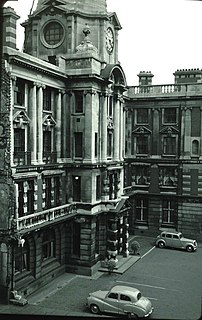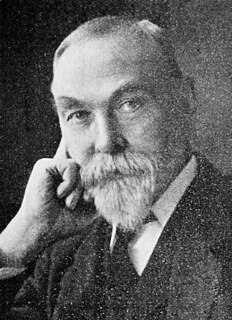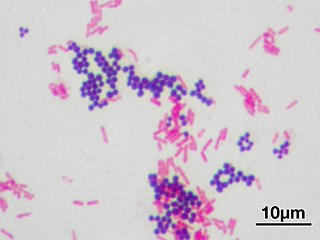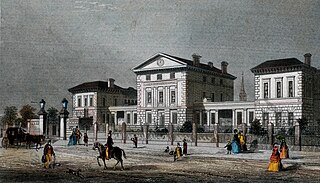
The Royal Free Hospital is a major teaching hospital in the Hampstead area of the London Borough of Camden. The hospital is part of the Royal Free London NHS Foundation Trust, which also runs services at Barnet Hospital, Chase Farm Hospital and a number of other sites. The trust is a founder member of the UCLPartners academic health science centre.

Manchester Royal Infirmary is a hospital in Manchester, England, founded by Charles White in 1752. It is now part of Manchester University NHS Foundation Trust, sharing buildings and facilities with several other hospitals.

Barnes Hospital in Cheadle, Greater Manchester, England, is a former hospital. It is on the border between Manchester and Stockport, near the A34 road in the middle of the complex interchange between Kingsway, the M60 and M56 motorway. The main building is Grade II listed, and lies on green belt land.
The index case or patient zero is the first documented patient in a disease epidemic within a population, or the first documented patient included in an epidemiological study. It can also refer to the first case of a condition or syndrome to be described in the medical literature, whether or not the patient is thought to be the first person affected. An index case can achieve the status of a "classic" case study in the literature, as did Phineas Gage, the first known person to exhibit a definitive personality change as a result of a brain injury.

The Huntsville Hospital Health System, also known as Huntsville Hospital, is a public, not-for-profit hospital organization consisting of several sites and buildings originating in the downtown area of Huntsville, Alabama. The Huntsville Hospital Health System has evolved and now owns or works with several other hospitals in Alabama. It has around 13,000 employees, 2,000 nurses and 650 physicians.

Nottingham City Hospital is a large hospital located in Nottingham, England. It occupies a large 90-acre (360,000 m2) site on the ring road to the North of the city centre. It is composed of many buildings, most of which are joined together by long corridors. Buildings include a leisure club, a Maggies Centre for people with cancer, and a patient hotel. It is managed by the Nottingham University Hospitals NHS Trust.

The National Centre for Infectious Diseases, previously known as the Communicable Disease Centre, is a national public health institute under the Ministry of Health of Singapore. Located next to Tan Tock Seng Hospital in Novena, all patients within the city-state who are affected with a highly contagious disease are also quarantined at the NCID and is used to control an outbreak of such diseases. The executive director of the hospital is Professor Yee-Sin Leo.

The University Hospital of South Manchester NHS Foundation Trust is a defunct NHS foundation trust that previously operated Wythenshawe Hospital, a major acute teaching hospital in Wythenshawe, Manchester. Many of the services and facilities previously at Withington Hospital were transferred to Wythenshawe in 2004. It provided services for adults and children at Wythenshawe Hospital and Withington Community Hospital. It runs Buccleuch Lodge Intermediate Care Unit and the Dermot Murphy Centre in Withington, and the Specialised Ability Centre in Sharston.

Fairfield Infectious Diseases Hospital, originally known as Queens Memorial Infectious Diseases Hospital, operated from 1904 to its closure in 1996. Perched high on the banks of the Yarra River at Yarra Bend in the inner Melbourne suburb of Fairfield, it developed an international reputation for the research and treatment of infectious diseases. When it closed, it was the last specific infectious diseases hospital in Australia.

Wythenshawe Hospital is an acute general hospital in Wythenshawe, South Manchester. It is managed by the Manchester University NHS Foundation Trust.

James Niven was a Scottish physician, perhaps best known for his work during the Spanish Flu outbreak in 1918 as Manchester's Medical Officer of Health. He held that position for 28 years (1894–1922), until he retired. He had previously been Oldham's Medical Officer of Health. He lectured in Public Health in Manchester. He committed suicide in 1925.
Anita Rachlis, M.D. is a Canadian HIV/AIDS researcher and is the principal author of the HIV treatment guidelines in Canada. She is an associate scientist at the Sunnybrook Research Institute, Sunnybrook Health Sciences Centre, in Toronto, Ontario, Canada.

The Victoria Integrated Care Centre is a health facility in Helensburgh, Scotland. It is managed by NHS Highland.

Ruchill Hospital was a fever hospital in the Ruchill area of Glasgow, Scotland. The hospital was closed in 1998 and was sold to Scottish Enterprise in July 1999. It was managed by NHS Greater Glasgow.
The United States Intelligence Community (IC) has a long history of producing assessments on infectious diseases. Most of these papers are distributed to government administrators and inform the choices of policymakers. Three of these assessments stand out as analytical products that have had important impact on the awareness, funding and treatment of infectious diseases around the world. The first paper is the National Intelligence Estimate on the Global Infectious Disease Threat, the second paper is the assessment on the Next Wave of HIV/AIDS, and the third paper was the assessment on SARS. This page summarizes the findings of these three papers and provides information about their impact.

King's Cross Hospital, often shortened to King's Cross is a hospital in Dundee, Scotland. It is managed by NHS Tayside.

Infectious diseases or ID, also known as infectiology, is a medical specialty dealing with the diagnosis and treatment of infections. An infectious diseases specialist's practice consists of managing nosocomial (healthcare-acquired) infections or community-acquired infections and is historically associated with hygiene, epidemiology, clinical microbiology, travel medicine and tropical medicine.

A fever hospital or isolation hospital is a hospital for infectious diseases such as scarlet fever and smallpox. Their purpose is to treat affected people while isolating them from the general population. Early examples included the Liverpool Fever Hospital (1801) and the London Fever Hospital (1802). other examples occurred elsewhere in the British Isles and India

The Edinburgh City Hospital was a hospital in Colinton, Edinburgh, opened in 1903 for the treatment of infectious diseases. As the pattern of infectious disease changed, the need for in-patients facilities to treat them diminished. While still remaining the regional centre for infectious disease, in the latter half of the 20th century the hospital facilities diversified with specialist units established for respiratory disease, ear, nose and throat surgery, maxillo-facial surgery, care of the elderly and latterly HIV/AIDS. The hospital closed in 1999 and was redeveloped as residential housing, known as Greenbank Village.

The Public Health Regulations 1985 is a statutory instrument of the United Kingdom which extended certain parts of the Public Health Act 1984 regarding notifiable diseases to AIDS. Therefore although AIDS was not classified as a notifiable disease, many of the powers which may be exercised in relation to notifiable diseases were also allowed in dealing with AIDS patients. The instrument was laid before Parliament on 21 March 1985, and came into effect the next day.

















